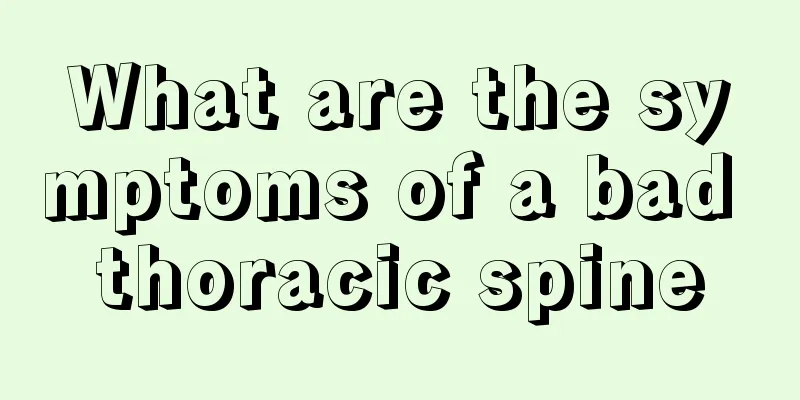What are the symptoms of a bad thoracic spine

|
Thoracic spondylosis is the most common type of spinal disease. Generally speaking, degenerative hyperplasia of the thoracic vertebrae is the main cause of thoracic spondylosis, and most patients suffer from lower thoracic vertebrae. Poor thoracic spine conditions may be caused by many diseases, such as thoracic disc herniation, thoracic spinal stenosis, thoracic joint disorder, thoracic bone hyperplasia or thoracic dislocation, etc. So what are the specific symptoms that patients with thoracic spine problems will experience? 1. What are the causes of thoracic spine problems? 1. The main pathological changes include thoracic disc herniation, disc micro-depression causing stenosis of the intervertebral space and intervertebral foramen, pseudovertebral slippage, bone hyperplasia at the vertebral margin and joints, and hypertrophy of the yellow ligament. The most common of these are intervertebral disc and intervertebral foraminal stenosis. 2. Aging and metabolic dysfunction and decline are the basic factors for the onset of the disease. The vast majority of them have a history of strain or cold, a history of trauma, postoperative recurrence or postoperative sequelae, and some patients also suffer from cervical, thoracic, and lumbar diseases. 2. What are the symptoms of a bad thoracic spine? Generally, it presents as chronic low back pain, chest pain, intercostal neuralgia, numbness of arms, shoulders and back, crawling sensation, excessive or no sweating, chest tightness, palpitations, dizziness, insomnia, indigestion, and in severe cases, unstable standing, difficulty walking, a feeling of tightness in the chest and abdomen, abnormal urination and defecation, paraplegia, etc. 1. The common manifestations of thoracic spondylosis are chest and back pain and kyphosis, and the chest pain is more severe when sitting in a bent position. 2. The pain caused by degeneration of the upper thoracic spine radiates to the front chest; 3. When the lower thoracic spine is diseased, the pain may radiate to the abdominal wall and is sometimes mistaken for angina pectoris. 4. If the hyperplasia stimulates the sympathetic nerves located beside the spine, it can cause autonomic nervous system symptoms such as circulatory disorders. 5. The patient suffers from kyphosis and thorax kyphosis due to narrowing of the intervertebral space. 6. The breathing range is reduced due to limited rib movement. 7. If the degeneration is severe and the spinal cord is compressed, numbness of the lower limbs and pyramidal tract signs may occur. 3. Treatment of thoracic spine problems 1. Non-surgical treatment (1) Rest: Depending on the severity of the disease, patients can choose to rest in bed, have general rest, or limit their activity. (2) Orthopedic massage and physical therapy can promote blood circulation, remove blood stasis, dredge meridians, and regulate tendons. (3) Drug treatment: including oral sedatives, external analgesic and anti-inflammatory ointments, blood circulation and blood stasis-removing drugs, and other effective treatment measures. 2. Surgical treatment Surgery is currently the only effective method for treating thoracic spinal stenosis. |
<<: How to turn yellowed shoe uppers white
>>: How to correct thoracic scoliosis
Recommend
What foods should you eat to prevent uterine cancer
Endometrial cancer is a common cancer that usuall...
What are the sequelae of bacterial meningitis?
The harm of bacterial meningitis itself is quite ...
How long can one live with advanced nasopharyngeal cancer
Some people are not familiar with the symptoms of...
Mole on the inside of your wrist?
It is a common phenomenon to have moles on the bo...
The reason why double eyelid swelling does not go down
Having eyes that are full of spirit and as beauti...
The cost of treating hamartoma
Regarding the cost of treating hamartomas, too ma...
What are the sequelae after a craniotomy in a car accident?
As the saying goes, there are unexpected changes ...
Pus behind the ear
The ear is one of the five senses of the human bo...
Can doing sit-ups help reduce belly fat?
In daily life, many people want to reduce belly f...
Will liver disease cause diarrhea
After liver disease occurs, people often feel ver...
What is the diagnosis method for tongue cancer
What is the diagnosis method for tongue cancer? A...
What causes blisters on feet?
Many people often get blisters on their feet beca...
What are the symptoms of Trichomonas urethritis?
Currently, Trichomonas urethritis is a common dis...
Can late-stage ovarian tumors be cured?
What are the folk remedies for treating ovarian t...
Success rate of vision correction surgery
Many people are always worried about the possibil...









